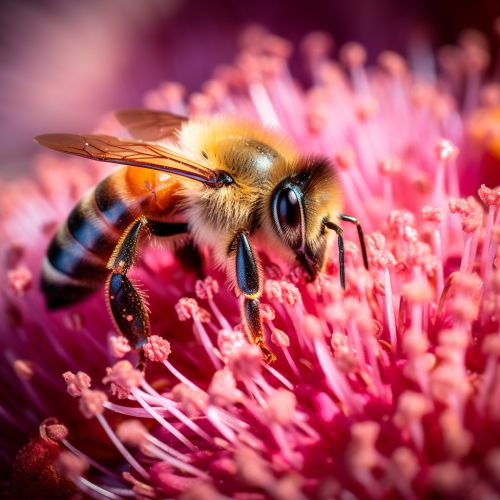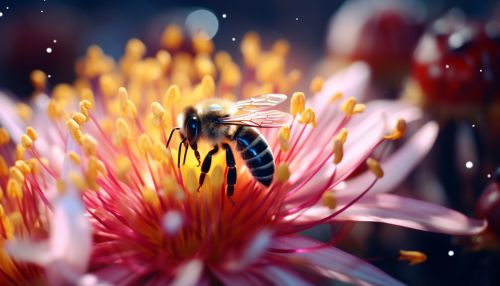Pollination
Introduction
Pollination is a crucial biological process that involves the transfer of pollen from the male anther of a flower to the female stigma. This process is essential for the fertilization of plants, leading to the production of seeds and the continuation of plant species. Pollination can be facilitated through various agents, including wind, water, and animals, with insects, particularly bees, being the most common animal pollinators.
Types of Pollination
There are two primary types of pollination: self-pollination and cross-pollination.
Self-Pollination
Self-pollination occurs when the pollen from the anther of a flower is transferred to the stigma of the same flower or another flower on the same plant. This type of pollination does not require an external agent, as the plant can fertilize itself. Self-pollination ensures reproduction in isolated conditions where pollinators are scarce. However, it limits genetic diversity, which can make the plant species more susceptible to diseases and environmental changes.
Cross-Pollination
Cross-pollination, also known as allogamy, involves the transfer of pollen from the anther of one flower to the stigma of another flower on a different plant of the same species. This type of pollination promotes genetic diversity, which can enhance the resilience and adaptability of plant species. Cross-pollination typically requires an external agent, such as wind, water, or animals.
Pollination Agents
Various agents facilitate the transfer of pollen in the process of pollination. These agents can be abiotic, such as wind and water, or biotic, including various animals like insects, birds, and bats.
Wind Pollination
Wind pollination, or anemophily, is a type of pollination where pollen is carried from one flower to another by the wind. Plants that rely on wind pollination typically produce small, lightweight, and dry pollen grains that can be easily carried by the wind. These plants often have inconspicuous flowers, as they do not need to attract pollinators.
Water Pollination
Water pollination, or hydrophily, is relatively rare and occurs when pollen is transported from one flower to another by water. This type of pollination is typically found in aquatic plants.
Animal Pollination
Animal pollination, or zoophily, involves animals carrying pollen from one flower to another. Various animals can act as pollinators, including insects, birds, bats, and even some mammals. Insects, particularly bees, are the most common pollinators.
Insect Pollination
Insect pollination, or entomophily, is a form of animal pollination where insects carry pollen from one flower to another. Insects are attracted to flowers by visual cues, such as color and shape, and olfactory cues, such as scent. They also benefit from this interaction by feeding on the nectar or pollen provided by the flowers.
Bird Pollination
Bird pollination, or ornithophily, involves birds, such as hummingbirds and sunbirds, carrying pollen from one flower to another. Birds are attracted to bright, colorful flowers that often produce a large amount of nectar.
Bat Pollination
Bat pollination, or chiropterophily, involves bats carrying pollen from one flower to another. Bats are attracted to large, nocturnal flowers that emit a strong scent.
Importance of Pollination
Pollination is a vital process in the life cycle of flowering plants. It enables fertilization, which leads to the production of seeds and the propagation of plant species. Pollination also has significant implications for agriculture, as many of the world's crops depend on pollination for fruit and seed production.
Threats to Pollination
Various factors threaten the process of pollination, including habitat loss, climate change, and the use of pesticides. These threats can lead to a decline in pollinator populations, which can have severe consequences for biodiversity and food security.
Conservation of Pollinators
Efforts to conserve pollinators are crucial to maintaining biodiversity and ensuring food security. These efforts can include creating pollinator-friendly habitats, reducing the use of pesticides, and promoting the importance of pollinators through education and outreach.
See Also
- Flower
- Pollen
- Bee
- Wind pollination
- Water pollination
- Animal pollination
- Insect pollination
- Bird pollination
- Bat pollination


